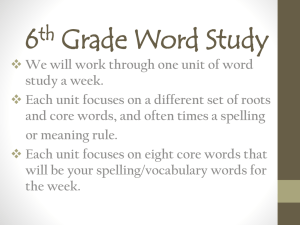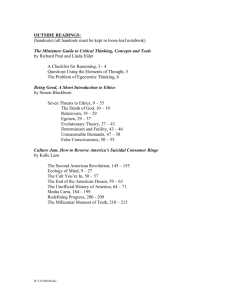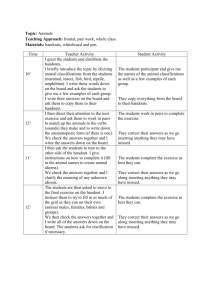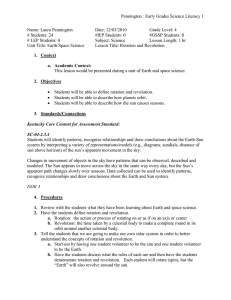Astronomy: Roundness, Rotation, Revolution, Moon, and Planets
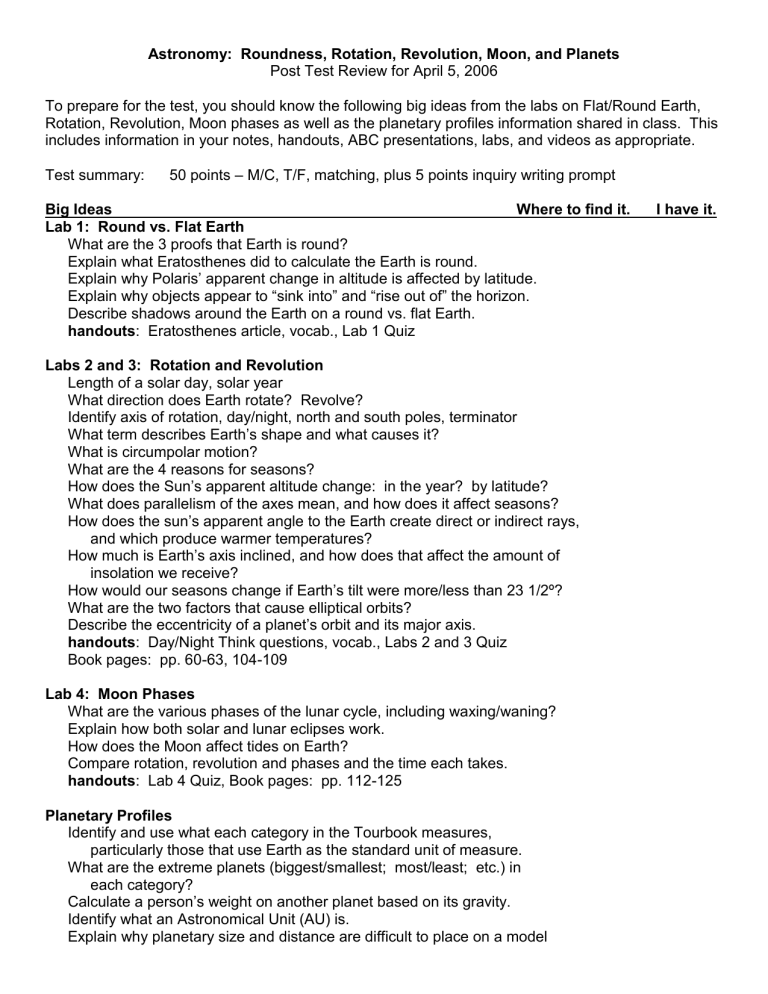
Astronomy: Roundness, Rotation, Revolution, Moon, and Planets
Post Test Review for April 5, 2006
To prepare for the test, you should know the following big ideas from the labs on Flat/Round Earth,
Rotation, Revolution, Moon phases as well as the planetary profiles information shared in class. This includes information in your notes, handouts, ABC presentations, labs, and videos as appropriate.
Test summary: 50 points
– M/C, T/F, matching, plus 5 points inquiry writing prompt
Big Ideas
Lab 1: Round vs. Flat Earth
What are the 3 proofs that Earth is round?
Where to find it.
Explain what Eratosthenes did to calculate the Earth is round.
Explain why Polaris’ apparent change in altitude is affected by latitude.
Explain why objects appear to “sink into” and “rise out of” the horizon.
I have it.
Describe shadows around the Earth on a round vs. flat Earth. handouts : Eratosthenes article, vocab., Lab 1 Quiz
Labs 2 and 3: Rotation and Revolution
Length of a solar day, solar year
What direction does Earth rotate? Revolve?
Identify axis of rotation, day/night, north and south poles, terminator
What term describes Earth’s shape and what causes it?
What is circumpolar motion?
What are the 4 reasons for seasons?
How does the Sun’s apparent altitude change: in the year? by latitude?
What does parallelism of the axes mean, and how does it affect seasons?
How does the sun’s apparent angle to the Earth create direct or indirect rays, and which produce warmer temperatures?
How much is Earth’s axis inclined, and how does that affect the amount of insolation we receive?
How would our seasons change if Earth’s tilt were more/less than 23 1/2º?
What are the two factors that cause elliptical orbits?
Describe the eccentricity of a planet’s orbit and its major axis. handouts : Day/Night Think questions, vocab., Labs 2 and 3 Quiz
Book pages: pp. 60-63, 104-109
Lab 4: Moon Phases
What are the various phases of the lunar cycle, including waxing/waning?
Explain how both solar and lunar eclipses work.
How does the Moon affect tides on Earth?
Compare rotation, revolution and phases and the time each takes. handouts : Lab 4 Quiz, Book pages: pp. 112-125
Planetary Profiles
Identify and use what each category in the Tourbook measures, particularly those that use Earth as the standard unit of measure.
What are the extreme planets (biggest/smallest; most/least; etc.) in each category?
Calculate a person’s weight on another planet based on its gravity.
Identify what an Astronomical Unit (AU) is.
Explain why planetary size and distance are difficult to place on a model
handouts : Planetary Profiles (The Solar System Tourbook)
Tools of the Astronomer
Identify the differences and purposes of various types of telescopes
Interpret the Hertzsprung-Russell Diagram (pp. 33-35)
Indicate the stages in stellar evolution (pp. 42-49) handouts : Tools of the Astronomer reading
